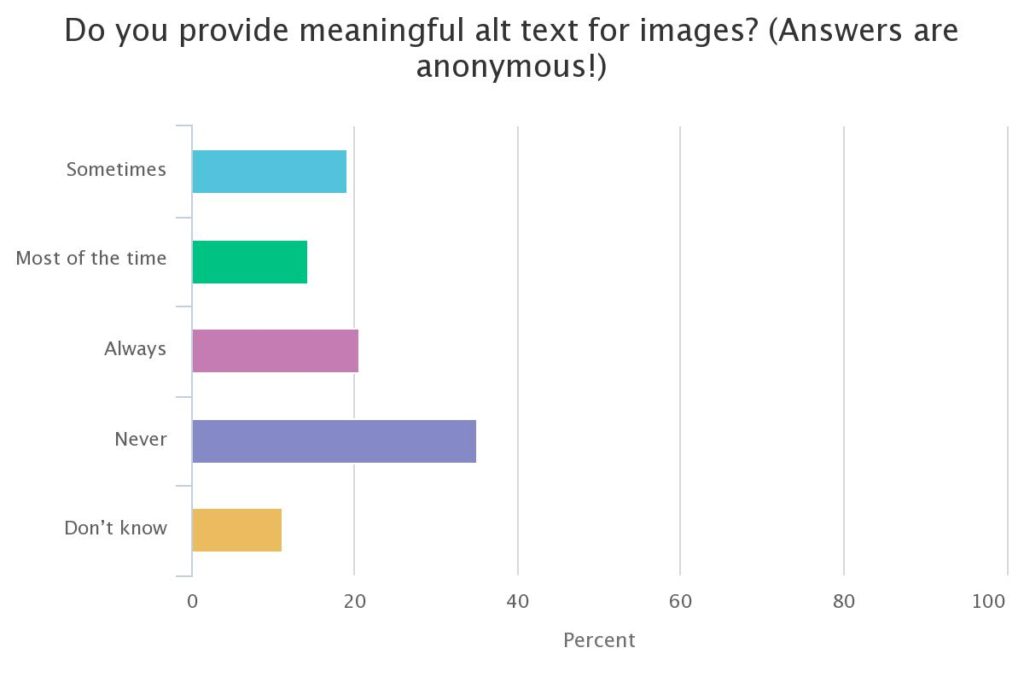 My recent webinar produced some encouraging surprises!
My recent webinar produced some encouraging surprises!
I gave a webinar on accessibility for Apex recently and the experience gave me a renewed sense of optimism about the prospects for accessibility to finally go mainstream.
Folks who know me are probably smiling, thinking “Bill, you’re always optimistic. Tell us something we don’t know.”
But really, it was striking.
First of all, there was a tremendous response to it: almost 250 people registered, and so many people actually attended that it maxed out Apex’s webinar capacity, so a few people were turned away. Clearly a lot of people were interested in knowing “What You Need to Know to Get Accessibility Right.”
(For anyone who missed it, the recording and slides are freely available to anybody now.)
Scholarly publishing is finally paying attention!
Another thing that struck me was that the attendees weren’t all book publishers. Until now, the vast majority of publishers addressing accessibility have been book publishers—mostly in education, and to some extent in trade. It has always bothered me that scholarly journal publishers have largely been stuck in not-very-accessible PDFs.
I wrote an article recently making the case that it’s time now for scholarly journals to get accessible. It appears that I’m not the only one thinking that way. It was clear that quite a few of the webinar attendees were scholarly, STM, and journal publishers.
Once you’ve got EPUB 3s you’re on the fast track to accessibility.
We always include some polling questions in these webinars, to learn things about the attendees that can help guide my remarks. I wish we had asked that basic question: what do you publish? One question we did ask was whether the attendees currently publish EPUB 2s, EPUB 3s, some of each, or neither. Implicit in that question was that the attendees would almost all be book publishers, and by now most book publishers do produce EPUBs.

For a given set of functionality, it’s just as easy to make EPUB 3s as EPUB 2s. EPUB 3 is designed for accessibility; EPUB 2 is not.
Two things surprised me about the response to that question. First, it was encouraging to see that over a third of the respondents said they publish EPUB 3s, and another third said they publish both, whereas only about 8% said they currently only publish EPUB 2s. That’s encouraging for a number of reasons.
First, one of the issues the industry is lamenting right now is the persistence of EPUB 2 and the misconception that EPUB 3 is just for EPUBs with interactive or multimedia features, when in fact for a given set of functionality, it’s just as easy to make EPUB 3s as EPUB 2s.
Why does this matter? Because EPUB 3 is designed for accessibility; EPUB 2 is not.
Clearly, for the folks attending my webinar—admittedly a self-selected bunch who are interested enough in accessibility to do so—most of them have already made the move to EPUB 3. That’s fantastic because once you’ve got EPUB 3s you’re on the fast track to accessibility.
But you may have noticed that those percentages don’t add up even close to 100%. That’s because about 45% of the respondents said they don’t produce EPUBs at all. While that may look discouraging, I actually thought it was based on a good thing. (Told you I’m always optimistic!)
I think it was because many of the attendees were journal publishers, and hardly any journal publishers publish EPUBs. As the presenter, I get to see who the attendees are, and as it happens I know a lot of them and their organizations. A surprising number were from scholarly and even STM publishers. Glad to see them interested in accessibility!
The all-important issue of alt text.
Another encouraging response was to the polling question about alt text. I very deliberately phrased the question this way: “Do you provide meaningful alt text for images?” The word meaningful is obviously the key. I was trying to filter out those who do common workarounds like alt=”” or alt=”image”.
By asking for meaningful alt text—with the options being “sometimes,” “most of the time,” “always,” “never,” or “don’t know”—I fully expected almost all of the responses to be either “never” or “don’t know.” I wanted to make the point that proper alt text is priority one, even if you’ve otherwise got good EPUB 3s.
But guess what? Only about a third said “never,” and another 10% said “don’t know.” (Most non-respondents were probably also in the “don’t know” category.) Fully 20% of the respondents said “always,” with another almost 20% saying “sometimes” and about 15% saying “most of the time.” That’s over half of the respondents doing meaningful alt text at least some of the time. Way to go, people!

Systems need to be accessible too.
We also got lots of questions, which of course I always answer by email because only a few can actually get answered live in the webinar. (Apex thought they were interesting enough that they’ve published a separate blog on the questions and answers.)
They were really good questions, indicating that people are thinking a lot about this. A couple of them prompted me to do a bit of research before responding. One led me, in a roundabout way, to another insight that is very encouraging.
The question was whether there are any guidelines or resources for finding government money or grants to update workflows or legacy content for accessibility. A good question that I don’t have a good answer for. I’m not aware of any such resources. But I certainly do think there are funders out there who might be interested in helping with this.
That led me to think about that batch of Mellon grants that were awarded a few years ago to a number of press-and-library partnerships in scholarly publishing, largely with university presses, to develop innovative systems that if successful would lead to free resources or open source software.
Accessible publications are useless if the people who need them can’t get to them because the discovery and delivery systems aren’t accessible.
Three of those projects that I have followed particularly closely are Editoria, from the University of California Press and California Digital Library, done in partnership with the Coko Foundation; Manifold from the University of Minnesota Press and CUNY working with Cast Iron Coding; and Fulcrum from the University of Michigan Press and Libraries. All three are platforms; Editoria is a content management and workflow platform, and Fulcrum and Manifold are publishing platforms. All three are working on building accessibility into those platforms.
That was actually no surprise, but it’s still encouraging because by making those platforms available to the scholarly publishing community, they encourage their client publishers to pay attention to accessibility.
Jon McGlone from Fulcrum responded in great detail to my inquiry as I was drafting my response to that question. He said they’re aiming for WCAG 2.0 AA as the baseline for the site; they’re requiring alt text for images; they have an accessible video player as part of the platform; their e-reader is based on EPUB, aligning with the EPUB Accessibility 1.0 spec; and they do regular functional accessibility testing with assistive technology.
That means that they are building Fulcrum to make the system itself accessible to people with disabilities. This is huge, and often overlooked. Accessible publications are useless if the people who need them can’t get to them because the discovery and delivery systems aren’t accessible.
There’s still work to be done.
But there was another important lesson from all three of those platforms, Editoria, Manifold, and Fulcrum. No matter how many accessibility features they build into their systems, they can’t make publishers use those features, or use them properly.
So I will end my usual optimistic message with one of tempered optimism.
One of the slides in my webinar makes the point that EPUB 3 and HTML 5 don’t guarantee accessibility; what they guarantee is accessibilityability: the ability to be accessible. You have to use them properly.
EPUB 3 and HTML 5 don’t guarantee accessibility; what they guarantee is accessibilityability: the ability to be accessible.
I’m hugely encouraged by the response to my webinar. And I’m hugely encouraged that systems now becoming available to publishers are being built for accessibility. Those are very positive signs. But by no means can we declare victory. There’s still plenty of work to be done.
Glad to know lots of people are working on it!
Want to know more? Contact Apex.